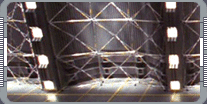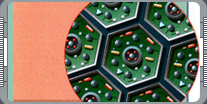
Holotechnology
In the 24th century, almost any experience or enviroment can be recreated, thanks to the development of
holotechnology.
 Psychologists realized long ago that being confined in a starship for extended periods of time can be mentally
unhealthly. Starfleet worked for years to create an energy-efficient, virtual-reality system to alleviate the
tedium of interstellar travel, and eventually came up with a Holographic Enviroment Simulator. This form of
holotechnology is commonly known as a holodeck, and can be used as a means of education, entertainment, or
simply relaxation. Holodeck technology became practical in the mid 24th century, at about the time
Galaxy-class ships were created, and quickly became a
requirement for deep space Starfleet starships.
Psychologists realized long ago that being confined in a starship for extended periods of time can be mentally
unhealthly. Starfleet worked for years to create an energy-efficient, virtual-reality system to alleviate the
tedium of interstellar travel, and eventually came up with a Holographic Enviroment Simulator. This form of
holotechnology is commonly known as a holodeck, and can be used as a means of education, entertainment, or
simply relaxation. Holodeck technology became practical in the mid 24th century, at about the time
Galaxy-class ships were created, and quickly became a
requirement for deep space Starfleet starships.
When the holodeck is not in use, it is simply a large, empty room with gridlines dividing the interior. However,
when activated, a holodeck can, through a combination of transporter-based matter replication and
three-dimensional image projection, simulate almost any enviroment or person.
A holodeck uses two main subsystems to create artificial enviroments, an imagery subsystem, and a matter
conversion subsystem. The holodeck imagery subsystem creates background scenery in a simulated enviroment. This
works in two ways: first, it generates 3D projections of distant objects - city lights, rolling hills, a blazing
sun - in a sophisticated extension of forced perspective. Secondly, this subsystem uses forcebeams to give
nearby objects the appearance of substance. The matter conversion subsystem uses both transporter and
 replicator technology to create real matter within the holodeck. This same technology is also used to create
lifelike interactive beings. These characters have real physical substance and are controlled by discreet
forcefield and tractor beams. Used in conjunction, these two subsystems can create a fully interactive
enviroment, so likelike as to be indistinguishable from the real thing. For example, the imagery subsystem can
generate an image of a telephone on a desk; if a user is about to pick up the receiver and dial, the matter
conversion subsystem creates an actual telephone. The main components of the holodeck are micro-miniature
omni-directional holo diodes (OHDs). Each size-sided OHD contains an optic section and a forcefield section.
Orchestrated by a computer, the OHDs create a world that appeals to all five senses, as simulations can project
sounds, smells, and tastes using speakers, atomizers, or replicated matter. The more complex the similation,
the more memory and power are required from the ship's computers.
replicator technology to create real matter within the holodeck. This same technology is also used to create
lifelike interactive beings. These characters have real physical substance and are controlled by discreet
forcefield and tractor beams. Used in conjunction, these two subsystems can create a fully interactive
enviroment, so likelike as to be indistinguishable from the real thing. For example, the imagery subsystem can
generate an image of a telephone on a desk; if a user is about to pick up the receiver and dial, the matter
conversion subsystem creates an actual telephone. The main components of the holodeck are micro-miniature
omni-directional holo diodes (OHDs). Each size-sided OHD contains an optic section and a forcefield section.
Orchestrated by a computer, the OHDs create a world that appeals to all five senses, as simulations can project
sounds, smells, and tastes using speakers, atomizers, or replicated matter. The more complex the similation,
the more memory and power are required from the ship's computers.
Holodecks are used by most Starfleet crew members, who tend to program their favorite simulations into the
computer so they can return to them over and over. Classic novels, periods in history, or famous locations are
just some of the simulations available on a holodeck. For instance, Captain Picard of the
USS Enterprise NCC-1701-E used the holodecks to relive the
adventures of his favorite fictional detective, Dixon Hill. Data also liked to use the holodeck for sleuthing;
his personal favorite was perhaps the most famous detective in literature - Sherlock Holmes.
There are normally three sets of controls for a holodeck. A small command console allows users to control the
holodeck before entering. Traditional voice commands can stop, freeze, replay, or adjust any situation. The
final control option is via the holodeck arch controls. The arch controls can appear within an ongoing
 simulation and provide communications and non-holodeck computer functions. Chief among the holodeck etiquette
rules is a ban on using a living person - especially someone serving on the same ship - as a model for personal
fantasy fulfillment. However, there is nothing within the holodeck systems that prevents anyone from doing just
that.
simulation and provide communications and non-holodeck computer functions. Chief among the holodeck etiquette
rules is a ban on using a living person - especially someone serving on the same ship - as a model for personal
fantasy fulfillment. However, there is nothing within the holodeck systems that prevents anyone from doing just
that.
Although a crew member can still break a leg while skiing, for example, safety features are built into the
holodeck that prevent serious injury or death. Safety systems can go offline, but this is unusual, and is
normally the result of shipwide difficulties. Some individuals establish a psychological dangerous dependency
on the holodeck; this condition is known as holodiction. Although not common, it is often very difficult to
resolve, especially as holodiction usually masks deeper problems. Shy Lieutenant Reginald Barclay tried to
boost his self-esteem by creating programs in which he could intimidate other crew members and which
exaggerated his own sex appeal. Happily, Barclay was able to regain his real-life self-confidence and cure his
holodiction. Most crew members, however, are able to simply enjoy the ride and use the holodeck for its
intended purposes.
|
|
"HOLOTECHNOLOGY" - NOVEMBER 1999 ISSUE 7 STAR TREK: THE MAGAZINE COPYRIGHT OF PARAMOUNT PICTURES.
|